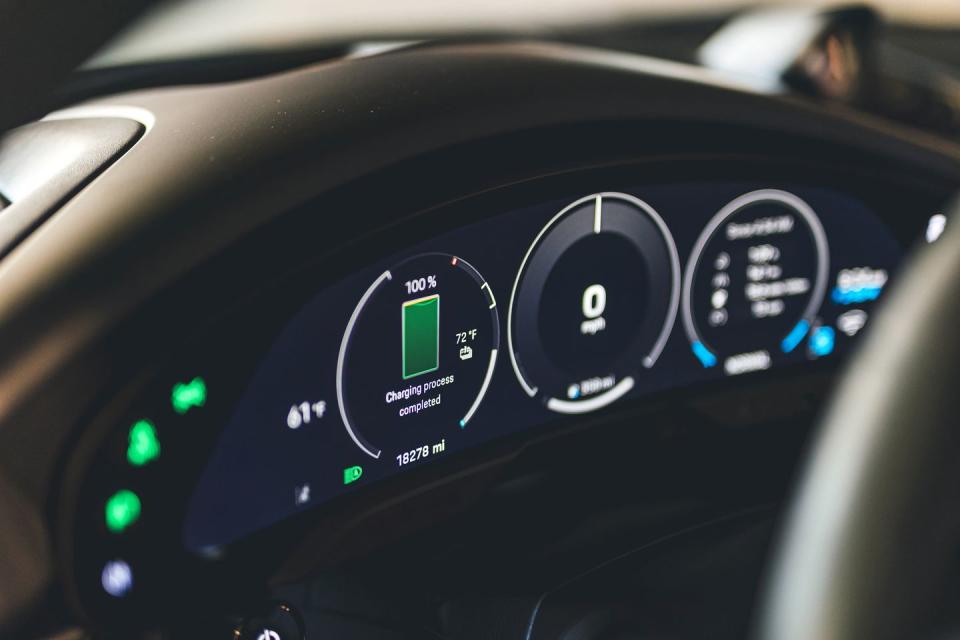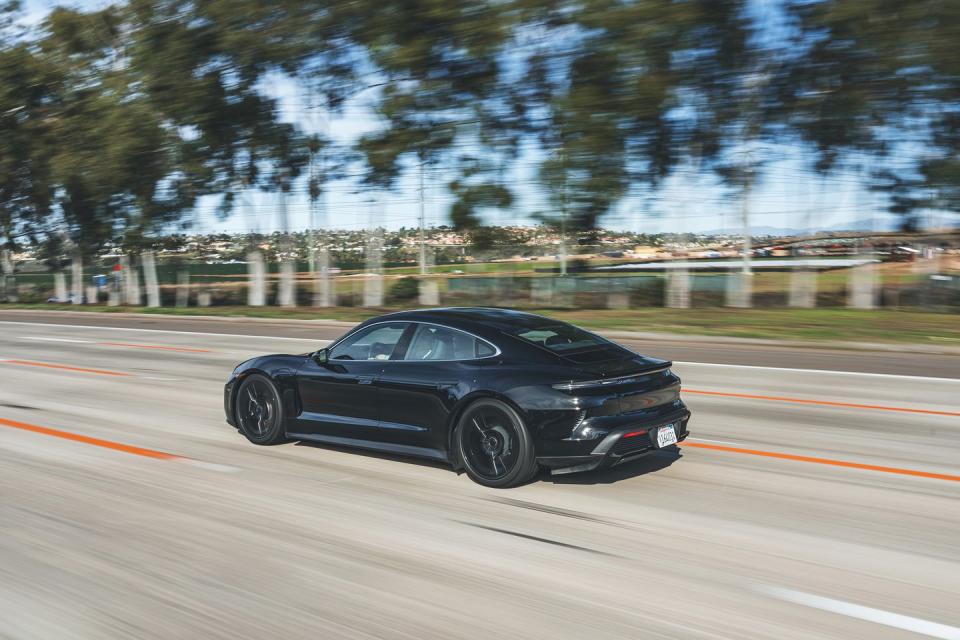2025 Porsche Taycan Prototype Test Reveals Greater Range, Quicker Charging

Porsche's Taycan holds a special place in our hearts, as Porsche's inaugural electric sports sedan is a blast to drive, especially for an EV. For the refreshed 2025 Taycan, Porsche set out to drastically improve both driving range and the fast-charging curve to enhance the consumer experience, and the company offered us an opportunity to test the merits of these updates in a 2025 prototype.
On first observation, one might not notice any exterior changes to the Taycan. And, truth be told, we questioned what was new in the sheetmetal ourselves. However, after a bit of time, a few things stood out, the first being aerodynamic changes to the front end. The Taycan appears lower and slightly wider, with additional cutouts in the front fascia below the headlights, and a more sculpted front trunk cover and fender area. The cars we previewed were entirely devoid of badging but otherwise without camouflage. Inside, our attention was drawn to new data available to the driver in relation to DC fast-charging. Within the left-side gauge cluster pod where the state of charge is visible, Porsche has added an indicator showing the maximum possible kilowatt charging rate, which increases as the battery's state of charge declines. A battery temperature readout is also present here and relevant to the available max charging rate.

The Taycan we drove was the long-range model, a rear-wheel-drive sedan riding on 19-inch wheels wrapped in "eDistance" rubber and equipped with the large battery pack (more on that later). Wearing Porsche-spec 225/55R-19 Michelin Pilot Sport 4 shoes up front and 275/45R-19 in the rear, this is nearly a direct comparison to the Taycan that we've achieved the highest range from, a 2021 rear-driver that returned 280 miles. Porsche attempted to gamify this range demonstration, pitting the journalists against each other to see who could get the best result. But we were more interested to run at the same GPS-verified 75 mph we use for our official range testing.
On a wonderful 70-degree day in Southern California, conditions couldn't be much better. Our drive route began in Marina del Rey, where we hopped on southbound I-405 headed for San Diego—and lunch. Our high-ish speed ate through more charge than expected, though, and the navigation system estimated a negative 9 percent battery state of charge at our final destination. So we trimmed a few miles off the route and reached our calorie-filling station after 191.7 miles of driving, still with 47 percent battery and 153 miles of range. At this point, after a few interchanges and the inevitable traffic slowdowns, the Taycan showed an average speed of 59 mph, so unfortunately direct range comparisons to our typical tests were out the window.
After replenishing our own energy, we made our way back north to our final destination at a public Electrify America station for what we hoped would be a brief charging experience. After traveling 313.2 miles, the pack showed 8 percent charge and 24 miles of remaining range. Running our driving data through our regression chart suggested a total driving range of 340 miles (rounded down to the nearest 10, as with all our range figures). Our average speed did not improve on the second leg of the drive, still holding at 59 mph, with much of this due to numerous stop signs and short bursts of urban driving. Our average speed was significantly higher while traveling on the highway, where a majority of the time was spent above 70 mph. Due to this overall lower speed, our observed 60-mile improvement over the previous car is not entirely comparable, but we would be surprised if a similarly equipped Taycan returned anything less than 310 to 320 miles on our local Michigan loop. Our indicated efficiency clocked in at 3.5 miles per kilowatt-hour, two-tenths higher than the 2021 model.

Maybe the most impressive part of the experience was range-estimate accuracy. After the first 40 miles, the car had recalibrated to our driving style and speed, and for the final 200 miles of the drive, the estimate for the remaining charge at destination was within 1 percent of our actual result at the ending point. Similarly, the range indicator was within about five miles of the estimate when we arrived. While this seems like a straightforward item for an EV to get right, this sort of precision is highly uncommon. This accuracy is a massive benefit to consumers who make extended drives or reach lower charge states frequently and helps to mitigate range anxiety. We are looking forward to more experience with the Taycan to determine if these estimates will remain reliable in more extreme conditions where more demand is placed on the battery.
When it came to charging, the new Taycan proved even more impressive. Porsche didn't discuss any numbers, only promising a "higher peak charging rate" and "an improved charging curve." This charging session was slightly different than our normal procedure, as we began with the battery at the aforementioned 8 percent compared to our usual 10. However, that proved to be insignificant. Almost immediately, the charging rate zoomed past 290 kilowatts. It quickly reached a 327-kW peak, and by the time eight minutes had passed, the battery had eclipsed a 50 percent state of charge. The rate remained above 200 kilowatts until the battery was three-quarters full, and at 16 minutes, 20 seconds, it reached 80 percent. The charging speed declined from there, however not as aggressively as most. As the state of charge reached 90 percent, the Taycan was still accepting electrons at a rate of 67 kilowatts. All told, the Taycan needed only 24 minutes, 45 seconds to reach the 90 percent bogey, with an average charging rate of 212 kilowatts. Through all of our previous Taycan fast-charging endeavors, the best result we achieved was a 257-kW peak, 33 minutes of charging (from 10 to 90 percent), and a 135-kW average. This amounts to an otherworldly improvement.

Starting from 8 percent rather than our standard 10 percent surely aided in its result, but nonetheless the new Taycan showed mighty impressive electron acceptance. The next highest average charging rate we've seen is 166 kilowatts by the Genesis GV70 Electrified, and the highest peak charging rate was 305 kilowatts by the Lucid Air Grand Touring. We'll have wait for an official test of a production-ready car, but the Taycan appears likely to take the charging crown.
We pumped just over 88.0 kilowatt-hours into our car, and using that as a reference we can surmise that this pack has certainly grown, nearing 100.0 kilowatt-hours of usable capacity—versus 83.7 for the current car.

In the end, we found both the range and charging to be improved with the refreshed Taycan, though the major charging-speed improvement is by far the more impressive result. As the infrastructure expands and public DC fast-charging stations become more reliable, maximum range will become less important. The ability to add over 250 miles of range in 20 minutes can only improve daily life with an EV. At least in range and charging, the refreshed Taycan is a winner.
You Might Also Like

 Yahoo Autos
Yahoo Autos 